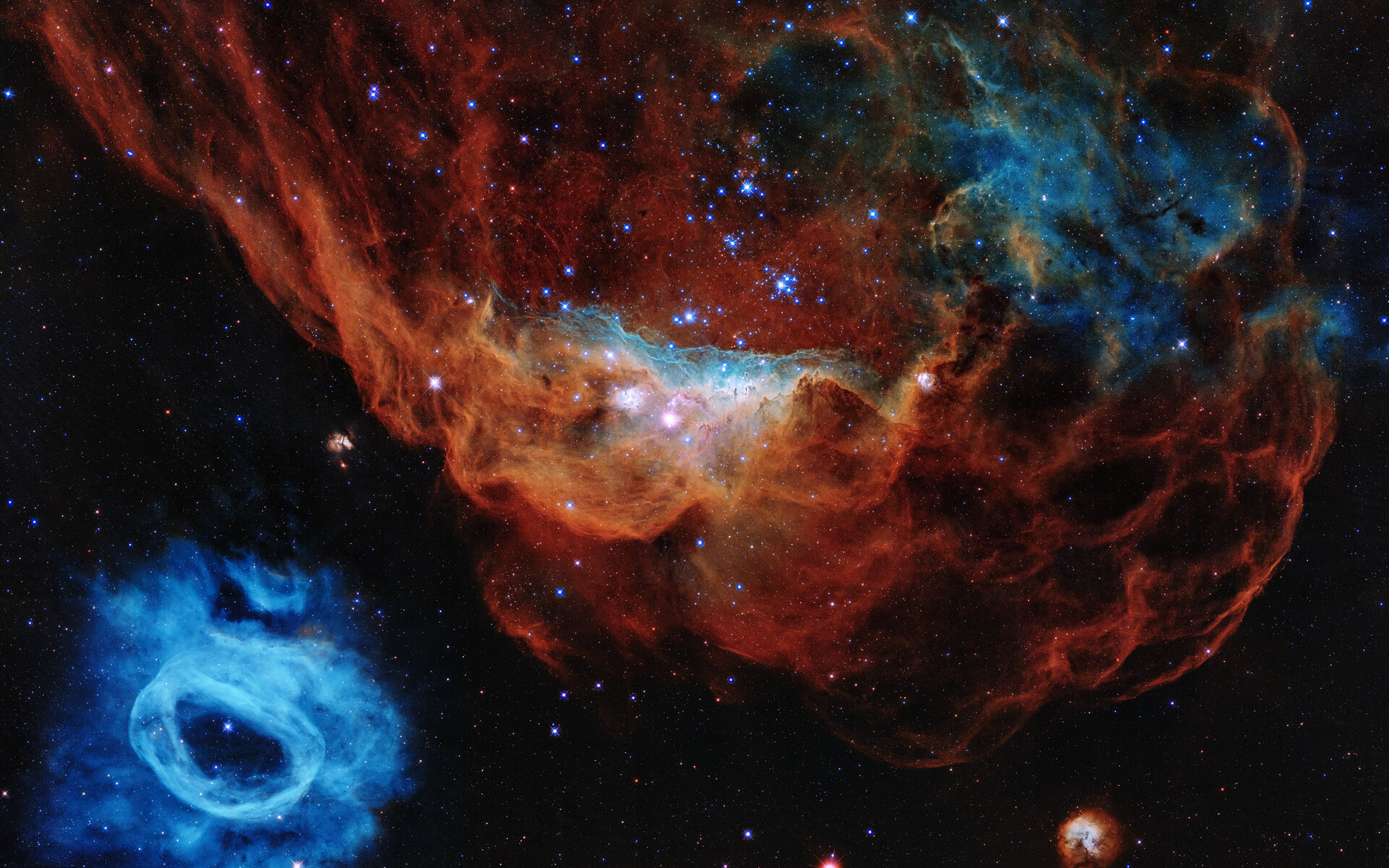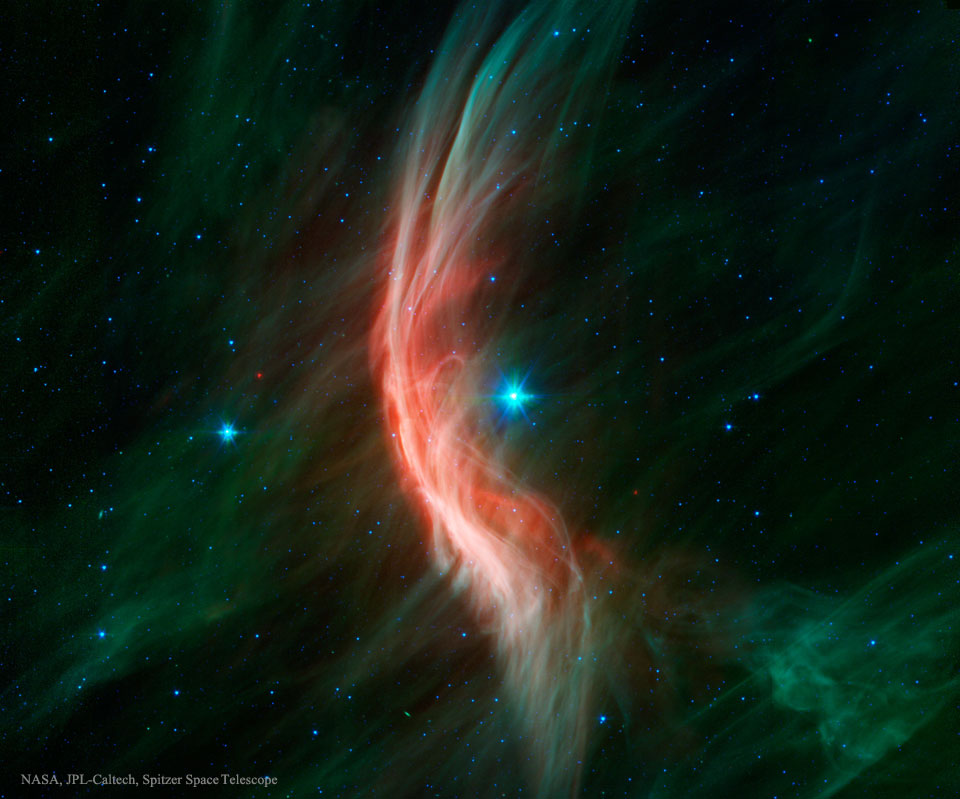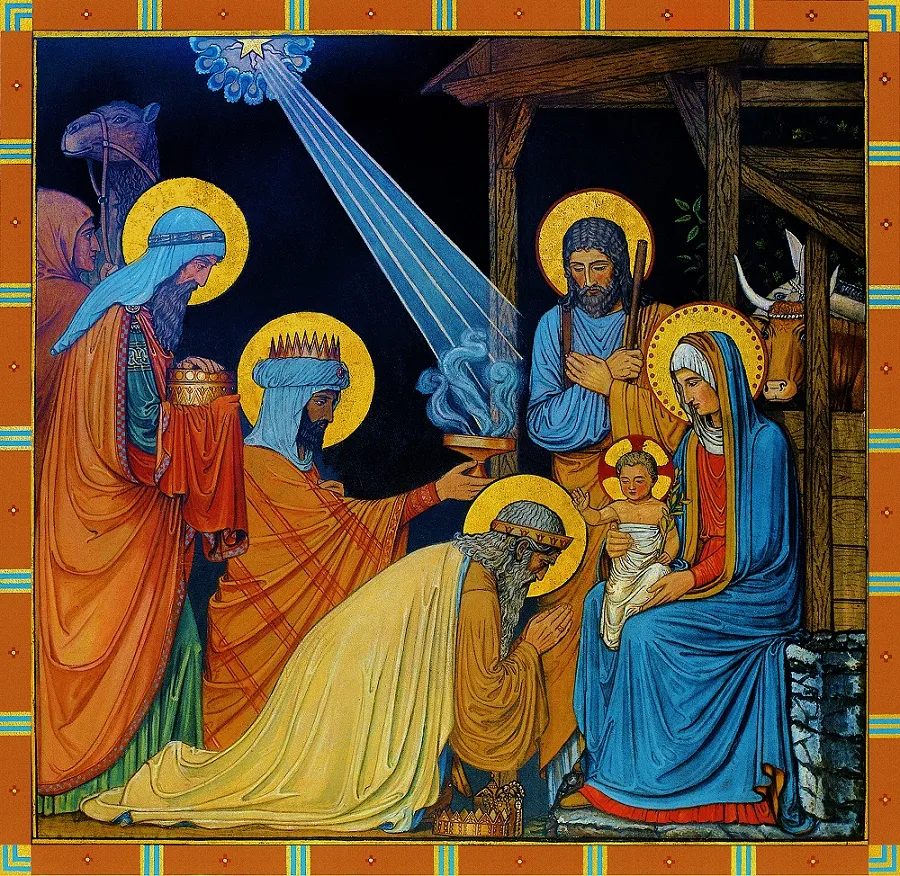Blog
Henry James “Red” Allen, Jr. (January 7, 1908 – April 17, 1967) was an American jazz trumpeter and vocalist whose playing has been claimed by Joachim-Ernst Berendt and others as the first to fully incorporate the innovations of Louis Armstrong.
Allen was born in the Algiers neighborhood of New Orleans, Louisiana, the son of the bandleader Henry Allen Sr. He took early trumpet lessons from Peter Bocage and Manuel Manetta.
Allen’s career began in Sidney Desvigne‘s Southern Syncopators. He was playing professionally by 1924 with the Excelsior Brass Band and the jazz dance bands of Sam Morgan, George Lewis and John Casimir. After playing on riverboats on the Mississippi River, he went to Chicago in 1927 to join King Oliver‘s band. Around this time he made recordings on the side in the band of Clarence Williams.
https://www.youtube.com/watch?v=W022m4oRLr4
more...This image is one of the most photogenic examples of the many turbulent stellar nurseries the NASA/ESA Hubble Space Telescope has observed during its 30-year lifetime. The portrait features the giant nebula NGC 2014 and its neighbour NGC 2020 which together form part of a vast star-forming region in the Large Magellanic Cloud, a satellite galaxy of the Milky Way, approximately 163 000 light-years away.

Alexandra Elene MacLean Denny (6 January 1947 – 21 April 1978) was an English singer-songwriter who was lead singer of the British folk rock band Fairport Convention. She has been described as “the pre-eminent British folk rock singer”.
After briefly working with the Strawbs, Denny joined Fairport Convention in 1968, remaining with them until 1969. She formed the short-lived band Fotheringay in 1970, before focusing on a solo career. Between 1971 and 1977, Denny released four solo albums: The North Star Grassman and the Ravens, Sandy, Like an Old Fashioned Waltz and Rendezvous. She also duetted with Robert Plant on “The Battle of Evermore” for Led Zeppelin‘s album Led Zeppelin IV in 1971. Denny died in 1978 at the age of 31 from head injuries sustained as a result of a fall down a flight of stairs.
Music publications Uncut and Mojo have described Denny as Britain’s finest female singer-songwriter.Her composition “Who Knows Where the Time Goes?” has been recorded by Judy Collins, Eva Cassidy, Nina Simone, Mary Black, Kate Wolf, Nanci Griffith, 10,000 Maniacs and Cat Power. Her recorded work has been the subject of numerous reissues, along with a wealth of previously unreleased material which has appeared over the more than 40 years since her death, including a 19-CD box set released in November 2010. She died on 21 April 1978 without regaining consciousness. Her death was ruled to be the result of a traumatic mid-brain haemorrhage and blunt force trauma to her head. She was 31 years old.
more...Ebo Taylor (born 1936) is a Ghanaian guitarist, composer, bandleader, record producer and arranger focusing on highlife and afrobeat music.
Ebo Taylor has been a pivotal figure on the Ghanaian music scene for over six decades. In the late 1950s he was active in the influential highlife bands the Stargazers and the Broadway Dance Band. In 1962, Taylor took his group, the Black Star Highlife Band, to London. In London, Taylor collaborated with Nigerianafrobeat star Fela Kuti as well as other African musicians in Britain at the time.
Returning to Ghana, Taylor worked as a producer, crafting recordings for Pat Thomas, C. K. Mann, and others, as well as exploring solo projects, combining traditional Ghanaian material with afrobeat, jazz, and funk rhythms to create his own recognizable sound in the 1970s. He was the inhouse guitar player, arranger, and producer for Essiebons, founded by Dick Essilfie-Bondzie.
Taylor’s work became popular internationally with hip-hop producers in the 21st century. In 1992, Ghetto Concept included his afrobeats in their music. In 2008, Ebo Taylor met the Berlin-based musicians of the Afrobeat Academy band, including saxophonist Ben Abarbanel-Wolff, which led to the release of the album Love and Death with Strut Records (his first internationally distributed album).
more...Earl Eugene Scruggs (January 6, 1924 – March 28, 2012 Cleveland County, North Carolina) was an American musician noted for popularizing a three-finger banjo picking style, now called “Scruggs style“, which is a defining characteristic of bluegrass music. His three-finger style of playing was radically different from the traditional way the five-string banjo had previously been played. This new style of playing became popular and elevated the banjo from its previous role as a background rhythm instrument to featured solo status. He popularized the instrument across several genres of music.
Scruggs’ career began at age 21 when he was hired to play in Bill Monroe‘s band, the Blue Grass Boys. “Bluegrass” eventually became the name for an entire genre of country music. Despite considerable success with Monroe, performing on the Grand Ole Opry and recording classic hits such as “Blue Moon of Kentucky“, Scruggs resigned from the group in 1946 because of their exhausting touring schedule. Fellow band member Lester Flatt resigned as well, and he and Scruggs later paired up in the duo Flatt and Scruggs. Scruggs’ banjo instrumental “Foggy Mountain Breakdown” was released in 1949 and became an enduring hit. The song experienced a rebirth of popularity to a younger generation when it was featured in the 1967 film Bonnie and Clyde. The song won two Grammy Awards and, in 2005, was selected for the Library of Congress’ National Recording Registry of works of unusual merit.
Flatt and Scruggs brought bluegrass music into mainstream popularity in the early 1960s with their country hit “The Ballad of Jed Clampett“, the theme music for the television sitcom The Beverly Hillbillies—the first Scruggs recording to reach number one on the Billboard charts. Over their 20-year association, Flatt and Scruggs recorded over 50 albums and 75 singles. The duo broke up in 1969, chiefly because, while Scruggs wanted to switch styles to fit a more modern sound, Flatt was a traditionalist who opposed the change and believed doing so would alienate a fan base of bluegrass purists. Although each of them formed a new band to match their visions, neither of them ever regained the success they had achieved as a team.
Scruggs received four Grammy awards, a Grammy Lifetime Achievement Award and a National Medal of Arts. He became a member of the International Bluegrass Music Hall of Fame and was given a star on the Hollywood Walk of Fame. In 1985, Flatt and Scruggs were inducted together into the Country Music Hall of Fame and named, as a duo, number 24 on CMT‘s “40 Greatest Men of Country Music”. Scruggs was awarded a National Heritage Fellowship by the National Endowment for the Arts, the highest honor in the folk and traditional arts in the United States. Four works by Scruggs have been placed in the Grammy Hall of Fame. After Scruggs’ death in 2012 at age 88, the Earl Scruggs Center was founded in Shelby, North Carolina, near his birthplace with the aid of a federal grant and corporate donors. The center is a $5.5 million facility that features the musical contributions of Scruggs and serves as an educational center providing classes and field trips for students.
more...Erev Shabbat Service Friday 1-5-24 6pm with Inbal Sharett-Singer, Jayson Rodowsky, Jeff Bailey, Pete Whitman and mick laBriola.
more...
At the heart of the Orion Nebula, are four hot, massive stars known as the Trapezium. Gathered within a region about 1.5 light-years in radius, they dominate the core of the dense Orion Nebula Star Cluster. Ultraviolet ionizing radiation from the Trapezium stars, mostly from the brightest star Theta-1 Orionis C powers the complex star forming region’s entire visible glow. About three million years old, the Orion Nebula Cluster was even more compact in its younger years and a dynamical study indicates that runaway stellar collisions at an earlier age may have formed a black hole with more than 100 times the mass of the Sun. The presence of a black hole within the cluster could explain the observed high velocities of the Trapezium stars. The Orion Nebula’s distance of some 1,500 light-years would make it one of the closest known black holes to planet Earth.

Paul Wertico (born January 5, 1953 in Chicago, Illinois) is an American drummer. He gained recognition as a member of the Pat Metheny Group from 1983 until 2001, leaving the group to spend more time with his family and to pursue other musical interests.
After Pat Metheny heard the Simon and Bard Group with Wertico and bassist Steve Rodby, he invited both to join his band. During his time with Metheny, Wertico played on ten albums and four videos, appeared on television, and toured around the world. He won seven Grammy Awards (for “Best Jazz Fusion Performance,” “Best Contemporary Jazz Performance,” and “Best Rock Instrumental Performance”), magazine polls, and received several gold records.
more...Laten John Adams Jr. (January 5, 1932 – September 14, 1998), was an American blues, jazz and gospel singer, known as “The Tan Canary” for the multi-octave range of his singing voice, his swooping vocal mannerisms and falsetto. His biggest hits were his versions of “Release Me” and “Reconsider Me” in the late 1960s.
Adams was born in New Orleans, Louisiana, United States, the oldest of 10 children. He became a professional musician on leaving school. He began his career singing gospel with the Soul Revivers and Bessie Griffin’s Consolators, but crossed over to secular music in 1959. His upstairs neighbor, the songwriter Dorothy LaBostrie, supposedly persuaded him to start performing secular music after hearing him sing in the bathtub. He recorded LaBostrie’s ballad “Oh Why,” released as “I Won’t Cry,” for Joe Ruffino’s Ric label. Produced by the teenaged Mac Rebennack (later known as Dr. John), the record became a local hit. Adams recorded several more singles for the label over the next three years, most of them produced by Rebennack or Eddie Bo. His first national hit came in 1962, when “A Losing Battle”, written by Rebennack, reached number 27 on the Billboard R&B chart.
more...
Alvin Ailey Jr. (January 5, 1931 – December 1, 1989) was an American dancer, director, choreographer, and activist who founded the Alvin Ailey American Dance Theater (AAADT). He created AAADT and its affiliated Alvin Ailey American Dance Center (later Ailey School) as havens for nurturing Black artists and expressing the universality of the African-American experience through dance.
Ailey’s work fused theater, modern dance, ballet, and jazz with Black vernacular, creating hope-fueled choreography that continues to spread global awareness of Black life in America. Ailey’s choreographic masterpiece Revelations is recognized as one of the most popular and most performed ballets in the world.
On July 15, 2008, the United States Congress passed a resolution designating AAADT a “vital American cultural ambassador to the World.”[4][5] That same year, in recognition of AAADT’s 50th anniversary, then Mayor Michael Bloomberg declared December 4 “Alvin Ailey Day” in New York City, while then-Governor David Paterson honored the organization on behalf of New York State.
Ailey was born to Alvin Ailey and Lula Elizabeth Cliff in Rogers, Texas, in his maternal grandfather’s home at the height of the Great Depression.
more...Elizabeth “Libba” Cotten Nevills; January 5, 1893 – June 29, 1987) was an American folk and blues musician. She was a self-taught left-handed guitarist who played a guitar strung for a right-handed player, but played it upside down. This position meant that she would play the bass lines with her fingers and the melody with her thumb. Her signature alternating bass style has become known as “Cotten picking”. NPR stated “her influence has reverberated through the generations, permeating every genre of music.”
Her album Folksongs and Instrumentals with Guitar (1958), was placed into the National Recording Registry by the Library of Congress, and was deemed as “culturally, historically, or aesthetically significant”. The album included her signature recording “Freight Train“, a song she wrote in her early teens. In 1984, her live album Elizabeth Cotten Live!, won her a Grammy Award for Best Ethnic or Traditional Folk Recording, at the age of 90. That same year, Cotten was recognized as a National Heritage Fellow by the National Endowment for the Arts.In 2022, she was posthumously inducted into the Rock and Roll Hall of Fame, as an early influence. Cotten was born in 1893 to a musical family near Chapel Hill, North Carolina, in an area that would later be incorporated as Carrboro.
more...Alegrias Flamenco Guitar
The structure of the Alegrias can change depending on whether you’re playing as a solo guitarist, accompanying a singer, or accompanying a dancer.
For the most part it’s a series of compás and falsetas. However, within this basic structure there’s some other material that act as a cue for dancers. Specifically, the llamada, silencio, and escobilla.
Letras
When accompanying a singer, the alegrias has between one and four letras, or sung verses. Each of these letras may have three or four 8-syllable lines.
The subject matter of the songs are often about sailors. This makes sense because Cadíz is a coastal city.
Note that guitarists will sometimes perform a letras section even without a singer.
Llamadas
Llamadas are dramatic, single compás sections that you’ll encounter in several flamenco forms. When accompanying a dancer, the main role of the alegrais llamada is to indicate a transition between sections. For instance, you might play a llamada to introduce or conclude a flaseta.
These are typically loud and intense phrases so that the dancer has a clear cue of what’s coming next.
Although most people associate the Alegrias with dancing, this is also one of the popualr forms to accompany a singer.
Escobilla
The Alegría includes two sections for the dancer, one of which is the escobilla. The escobilla is a section when the dancer shows off their fancy footwork. This two compás phrase includes a virtuosic guitar solo and gradual increase in rhythm.
Silencio
A second section that accompanies the dancer is the silencio. The silencio is a slow and dramatic section that’s usually played in the parallel minor key. For instance, if you were originally in the key A major, then the silencio would be played in the key A minor.
Because this section is more of a guitar solo, guitarists can take some liberty with the rhythm. Therefore, this section can be played either with a strict compás rhythm, or more freely with rubato. The silencio usually lasts for six compáses cycles.
more...Runaway star Zeta Ophiuchi produces the arcing interstellar bow wave or bow shock seen in this stunning infrared portrait. In the false-color view, bluish Zeta Oph, a star about 20 times more massive than the Sun, lies near the center of the frame, moving toward the left at 24 kilometers per second. Its strong stellar wind precedes it, compressing and heating the dusty interstellar material and shaping the curved shock front. What set this star in motion? Zeta Oph was likely once a member of a binary star system, its companion star was more massive and hence shorter lived. When the companion exploded as a supernova catastrophically losing mass, Zeta Oph was flung out of the system. About 460 light-years away, Zeta Oph is 65,000 times more luminous than the Sun and would be one of the brighter stars in the sky if it weren’t surrounded by obscuring dust. The image spans about 1.5 degrees or 12 light-years at the estimated distance of Zeta Ophiuchi. In January 2020, NASA placed the Spitzer Space Telescope in safe mode, ending its 16 successful years of exploring the cosmos.

Pablo Rodríguez Lozada (January 4, 1923 – February 28, 1973), better known as Tito Rodríguez, was a Puerto Rican singer and bandleader. He started his career singing under the tutelage of his brother, Johnny Rodríguez. In the 1940s, both moved to New York, where Tito worked as a percussionist in several popular rhumba ensembles, before directing his own group to great success during the 1950s. His most prolific years coincided with the peak of the mambo and cha-cha-cha dance craze. He also recorded boleros, sones, guarachas and pachangas.
Rodríguez is known by many fans as “El Inolvidable” (The Unforgettable One), a moniker based on his most popular song, a bolero written by Cuban composer Julio Gutiérrez.
more...More Posts
- The Cosmos with NGC 7023
- Augustus Pablo Day
- Nils Lofgren Day
- Chuck Anderson Day
- Skip James Day
- World Music with Alam Khan
- Daily Roots with Jahmiel
- Happy Summer Solstice 2020
- Music for Surviving the Pandemic and Realizing Racial Justice
- The Cosmos with NGC 6302
- Mickey Most Day
- Lazy Lester Day
- Eric Dolphy Day
- Chet Atkins Day
- World Music with Habit Nebizade
- Daily Roots with Frankie Paul
- Happy Juneteenth 2020
- Performing on Zoom with Club Calabash
- Music for Surviving the Pandemic and Realizing Racial Justice
- The Cosmos with NGC 7331
